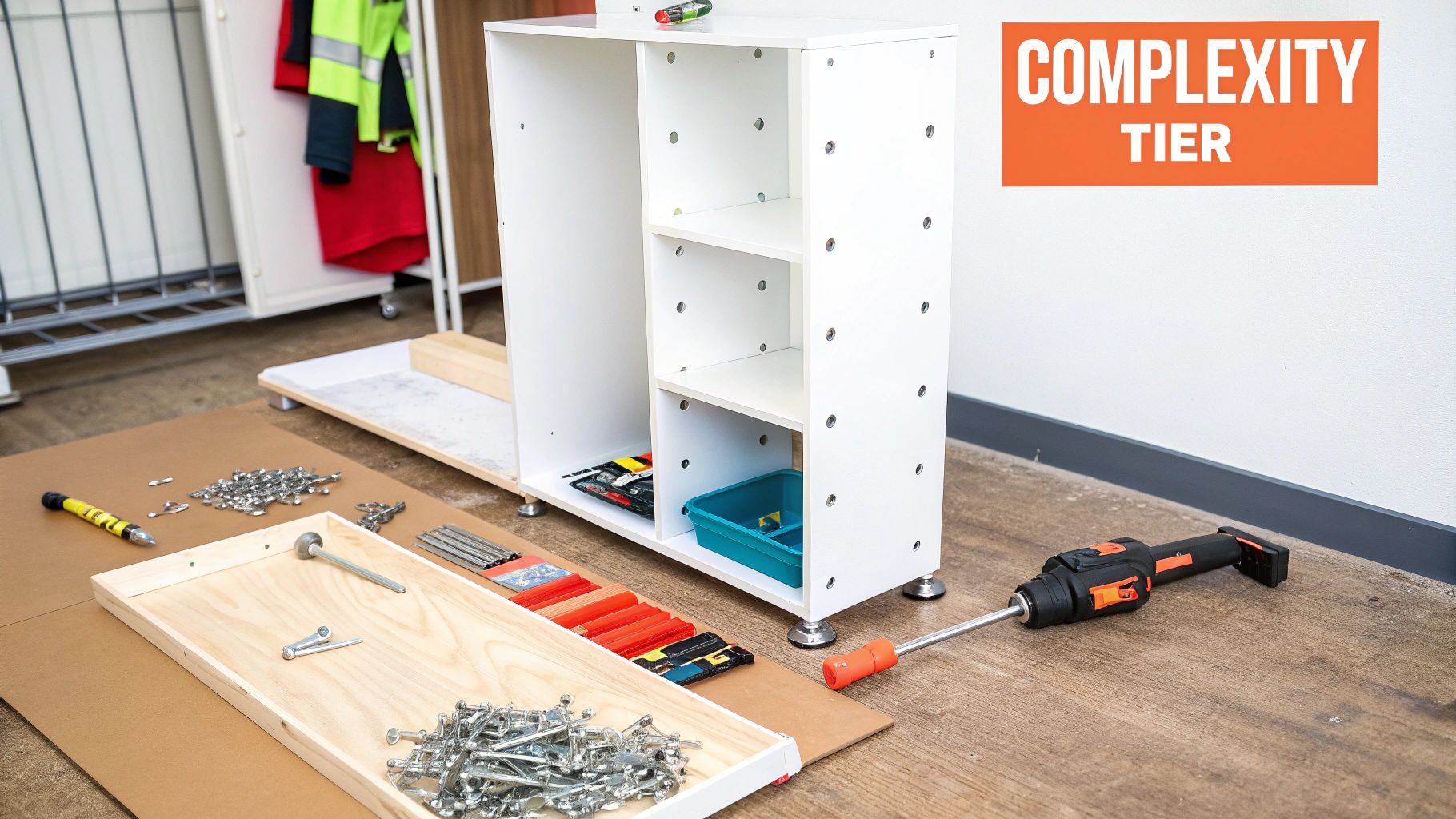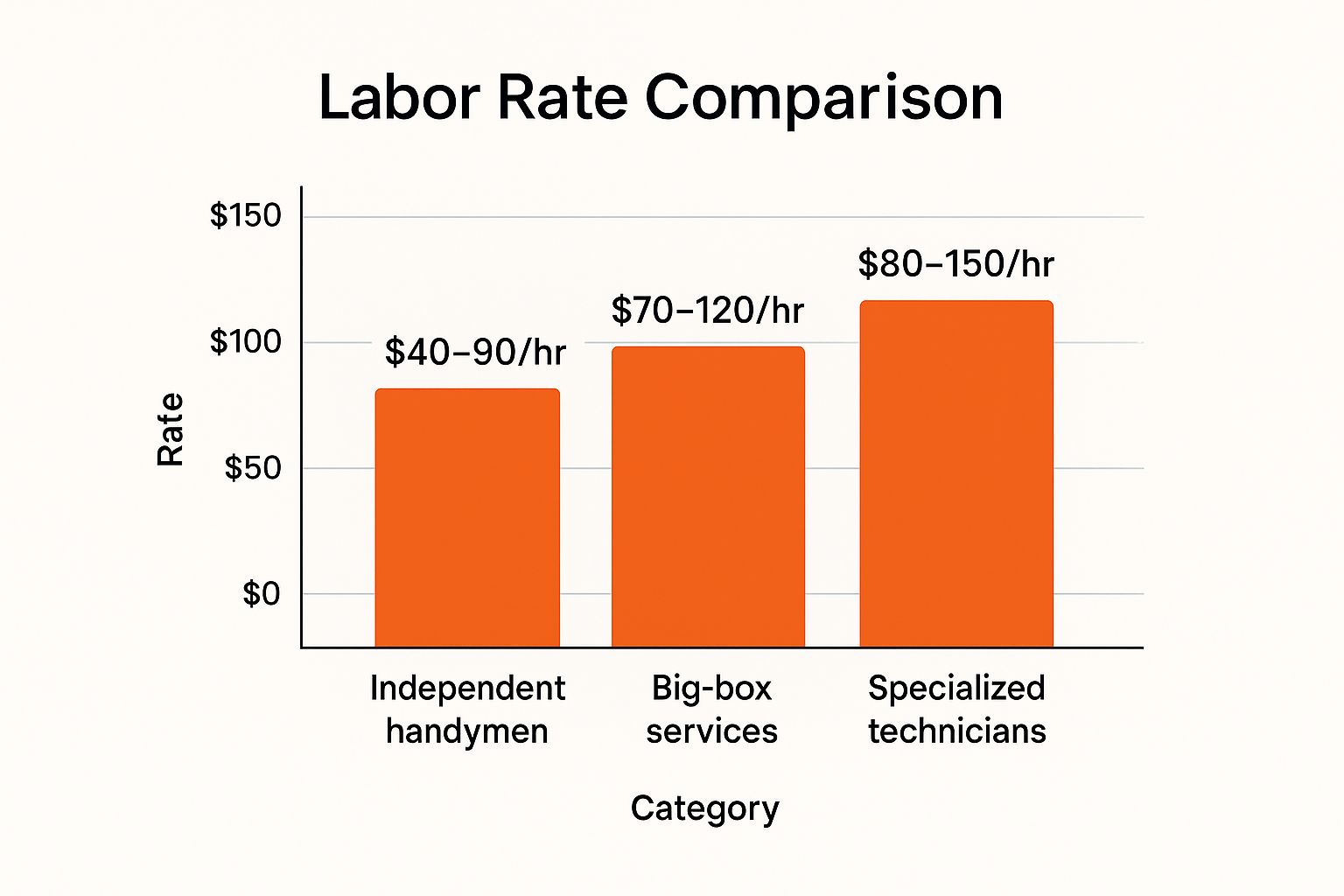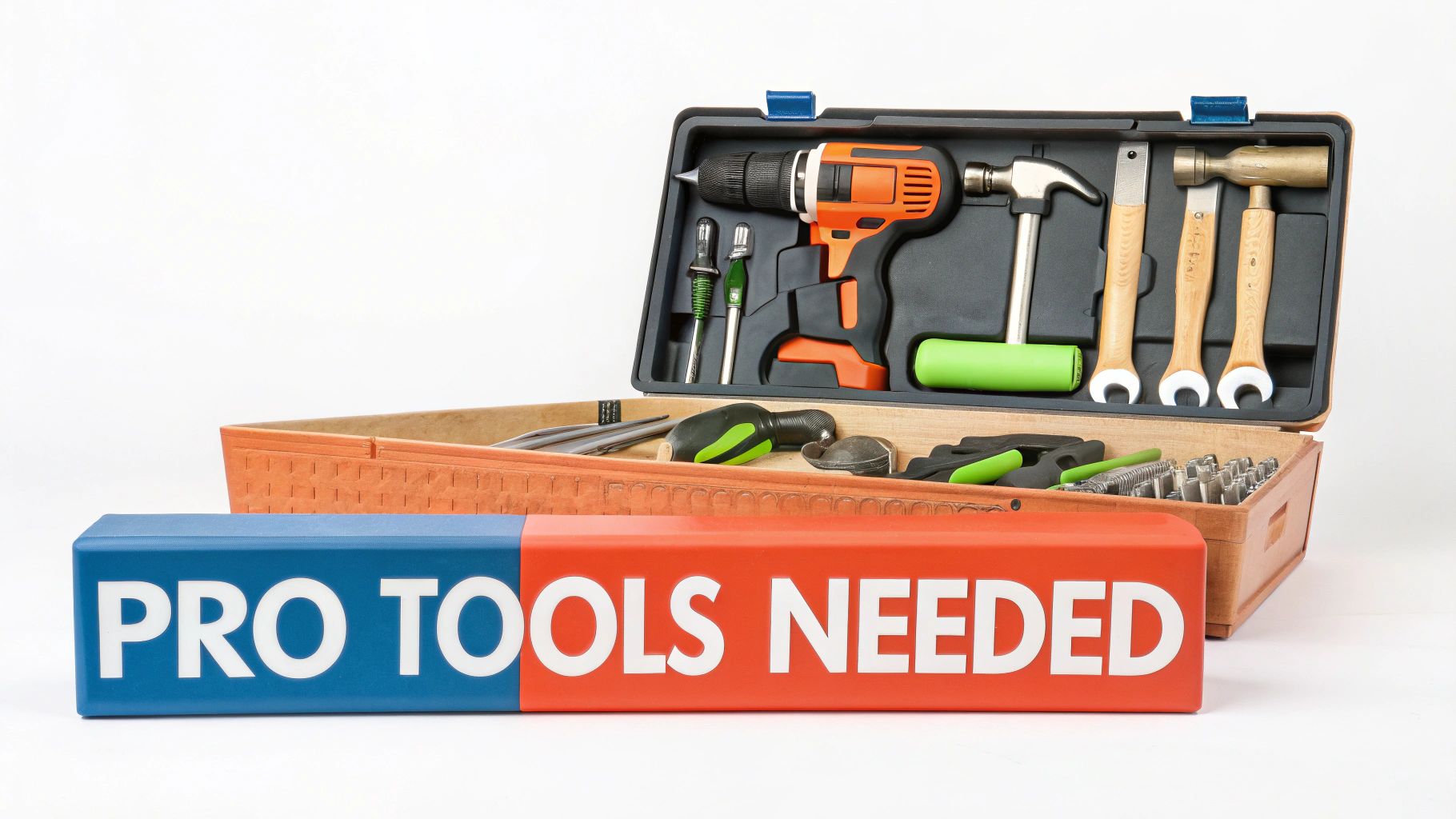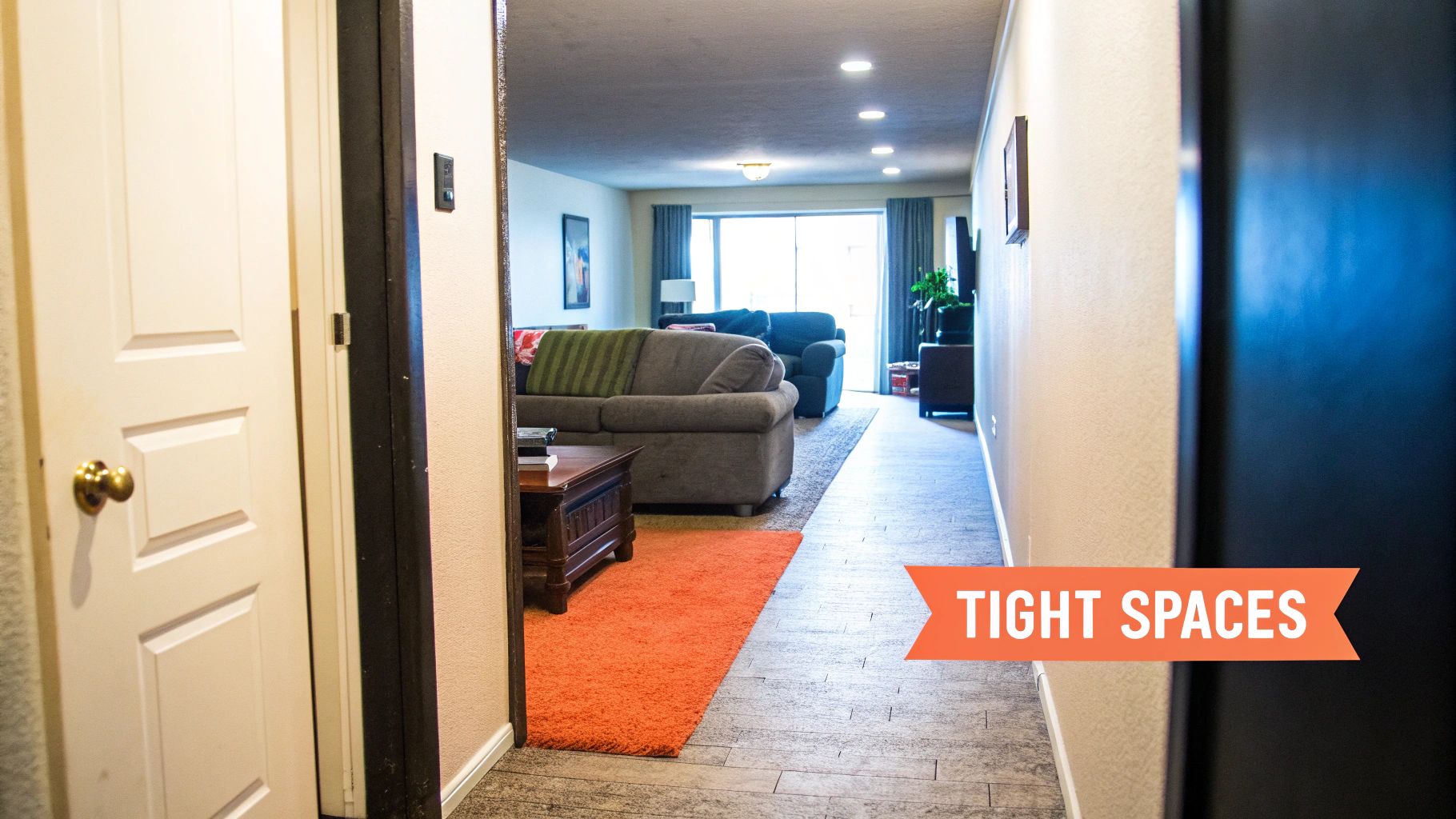-
CALL US:
- (866) 952-3456
Buying ready-to-assemble furniture can save money, but what about assembly? This listicle breaks down the often-hidden costs of furniture assembly, helping you budget effectively and avoid surprises. Understanding factors influencing furniture assembly cost—from furniture complexity and labor rates to required tools and time—empowers you to make informed decisions. Whether you're a busy professional, a parent, or simply want to furnish your home efficiently, this list covers key considerations for various needs and lifestyles, including accessibility and space constraints. Learn how these factors impact your total furniture assembly cost and save both time and money.
Furniture complexity is a primary driver of furniture assembly cost. The more complex a piece of furniture is, the more it will typically cost to have assembled. This is because complex furniture requires more time, specialized skills, and attention to detail. Items with numerous components, intricate mechanisms like drawers or extending leaves, and unique fastening systems all contribute to increased assembly time and, consequently, higher labor costs. Understanding this relationship is crucial for both setting appropriate assembly fees (if you're a provider) and budgeting for assembly services (if you're a customer).

For example, imagine assembling a simple bookcase versus a large wardrobe system with sliding doors and internal drawers. The bookcase might involve a few shelves and sides, while the wardrobe could have dozens of components and complex hardware. This difference in complexity directly translates to furniture assembly cost. As seen with examples like IKEA's PAX wardrobe systems, which often cost 2-3 times more to assemble than a basic IKEA bookcase, the complexity significantly impacts the final price. Similarly, adding leaf extensions to a Structube dining table typically adds $30-50 to the assembly cost compared to a standard fixed table. This is because the extension mechanisms require more intricate assembly and adjustments.
This factor deserves its place on this list because it is fundamental to understanding how furniture assembly costs are determined. Whether you're a busy professional, a DIY novice, or a family with children, recognizing the role of complexity helps you make informed decisions about purchasing and assembly.
Features to consider:
Pros of considering furniture complexity:
Cons of considering furniture complexity:
Tips for managing furniture assembly costs related to complexity:
Companies like IKEA and TaskRabbit have popularized the concept of tiered pricing based on furniture complexity, showcasing the practical application of this factor in real-world scenarios. IKEA's furniture complexity rating system and TaskRabbit's tiered pricing model for furniture assembly are prime examples of successful implementation.
Learn more about Furniture Complexity
When budgeting for furniture assembly, labor costs are the most significant factor to consider. These costs represent a substantial portion – typically 70-80% – of the total furniture assembly cost. Understanding how these rates are determined and what influences them is crucial for managing your expenses. Labor rates are influenced by a variety of factors including geographic location, the assembler's experience and skill level, demand for services, and whether you hire a union or non-union worker. This means that the furniture assembly cost for the same piece of furniture can differ drastically based on where you live and who you hire.

The bar chart above visualizes the average hourly rates for furniture assembly across various US cities, highlighting the geographical impact on labor costs. As you can see, metropolitan areas like New York City command significantly higher rates compared to smaller cities or rural areas. This visualization also breaks down the average cost by experience level, demonstrating how a more experienced assembler often charges more. The chart clearly illustrates that location and experience are primary drivers of furniture assembly costs.
Labor rates can be structured as hourly rates or flat fees. Hourly rates offer transparency, ensuring you only pay for the actual time spent on assembly. This approach is beneficial for complex furniture pieces that might take longer to assemble. Flat-fee structures provide predictable budgeting, allowing you to know the total cost upfront. This can be particularly helpful for simpler furniture assembly projects.
Features:
Pros:
Cons:
Examples:
Tips:
Popularized By:
Labor rates deserve a prominent place on this list because they directly impact the overall furniture assembly cost. Understanding the factors that influence these rates empowers consumers to make informed decisions and manage their budgets effectively. Whether you’re a busy professional, a first-time furniture buyer, or simply someone seeking a hassle-free assembly experience, considering labor costs is crucial for a smooth and cost-effective process.
A significant factor influencing furniture assembly cost is the tools and equipment required. Many furniture pieces, especially ready-to-assemble (RTA) furniture, necessitate specialized tools that go beyond the standard screwdrivers and hammers found in most household toolkits. This need for specialized equipment can significantly impact the overall assembly cost, either through tool rental fees or by increasing the rates charged by professional assembly services who bring their own professional-grade equipment.

This aspect of furniture assembly cost deserves attention because it's often an unseen expense, especially for first-time furniture buyers. Features like specialized hardware (think IKEA's ubiquitous hex keys), the necessity of power tools such as drills and impact drivers, precision measurement tools for complex assemblies, and even heavy lifting equipment for large items like wardrobes or office desks, all contribute to the final cost. For example, a wall-mounted entertainment center might require a stud finder and a power drill, while some IKEA beds necessitate an impact driver for proper and secure installation. Heavy office desks often need furniture dollies or multiple people for safe positioning and maneuvering, which can add to labor costs.
Professional assembly services typically factor tool costs into their overall rates, simplifying the process for the customer. Using the correct tools ensures accurate assembly, prevents damage to the furniture, and ultimately contributes to the longevity of the piece. However, for those opting for DIY assembly, purchasing these specialized tools, which might only be used once, adds a hidden cost not always factored into the initial purchase price of the furniture. This can make seemingly affordable furniture surprisingly expensive.
Pros:
Cons:
Tips for managing tool-related furniture assembly costs:
This factor is particularly relevant to busy professionals and working parents who may lack the time or the necessary tools for DIY assembly, as well as DIY novices and first-time furniture buyers who may be unaware of these hidden costs. Families with children seeking safe play equipment, seniors, and individuals with limited mobility may also find professional assembly a worthwhile investment to ensure safe and correct construction. Understanding the tool requirements beforehand allows for informed decisions and helps avoid budget overruns related to furniture assembly cost.
Time is money, and that's especially true when it comes to furniture assembly costs. This factor significantly influences the overall expense, particularly if you're hiring professional assemblers who charge by the hour. Understanding how time requirements affect furniture assembly cost is crucial for effective budgeting and project planning.
Different furniture types have vastly different assembly times. A simple bookcase might take 30-60 minutes, while a complex wardrobe with multiple doors and drawers could require 3-5 hours. Other common furniture items and their estimated assembly times include:
Several factors influence assembly speed:
Most professional assembly services utilize time-based pricing structures. They may provide an estimated quote upfront based on the furniture type and their experience. Understanding this pricing model allows you to better compare quotes and anticipate potential costs.
Pros of considering time requirements:
Cons of relying solely on time estimates:
Tips for managing assembly time and cost:
Popularized by IKEA's time estimate icons and Wayfair's difficulty ratings, understanding time requirements is a crucial aspect of managing furniture assembly costs. By considering these factors, you can make informed decisions, budget effectively, and ensure a smooth and efficient assembly process. This is particularly important for busy professionals, working parents, DIY novices, and anyone seeking to minimize the time and expense associated with furniture assembly.
When budgeting for new furniture, don't forget to factor in assembly. The type of service provider you choose plays a significant role in the overall furniture assembly cost, as well as the quality and reliability of the assembly itself. Understanding the different options available can save you money and headaches down the line. This factor is crucial for everyone from busy professionals and working parents to DIY novices and first-time furniture buyers, ensuring a smooth and stress-free experience. Even families with children needing play equipment assembled, seniors, or individuals with limited mobility benefit from understanding the nuances of service provider types.
The spectrum of assembly services ranges from independent handymen found through local ads or word-of-mouth, to manufacturer-certified specialists, and even large platform-based services. Each tier comes with its own cost structure, affecting your final furniture assembly cost. For instance, an independent contractor might offer a lower hourly rate than a professional service, while a manufacturer-authorized assembler could provide specialized expertise for complex furniture. Platform services like TaskRabbit offer a middle ground, connecting you with vetted assemblers with varying skill levels and pricing. Learn more about Service Provider Type to explore various service options and their impact on cost.
Here's a breakdown of the key features to consider when evaluating service providers:
Pros and Cons of Different Service Provider Types:
Examples of Furniture Assembly Costs:
Actionable Tips for Choosing a Service Provider:
Choosing the right service provider type is a critical factor influencing furniture assembly cost. By understanding the different options available, their associated pros and cons, and following these tips, you can make an informed decision that balances your budget with your need for quality and reliable assembly. Whether you are a busy homeowner, a senior needing assistance, or a family setting up a new play area, considering these aspects will contribute to a positive and stress-free experience.
Where your furniture needs to be assembled plays a significant role in the overall furniture assembly cost. This factor encompasses everything from accessing the assembly space itself to navigating the furniture through doorways and hallways. Failing to account for these logistical challenges can lead to unexpected surcharges and significantly increase your expenses. This is a critical component of furniture assembly cost calculation, especially in urban environments or homes with unique layouts.

Several key features determine the impact of location accessibility on furniture assembly cost: the floor level of the assembly location, the availability of elevators or the necessity of using stairs, the space available within the room for assembly, and any restrictions on the delivery path. For instance, ground-floor assembly typically avoids extra charges, while walk-up apartments often incur additional fees, sometimes $25-$50 per floor. Similarly, assembling a large item in a cramped dorm room can significantly slow down the process, potentially doubling both assembly time and cost. Remote locations outside a service area may also incur travel surcharges, often calculated per mile. Think of it like this: the harder it is to get the furniture to the assembly location and the less space there is to work, the higher the cost.
Consider these real-world examples: in New York City, walk-up apartments typically add $20-$30 per floor for assembly services. Assembling furniture in tight spaces like dorm rooms or small apartments may add 25-50% to the base assembly price. Finally, remote locations outside a standard service area might add a travel surcharge of $0.50-$1.00 per mile. These additional costs can quickly add up, making it crucial to consider location accessibility when budgeting for furniture assembly.
To avoid unexpected costs and ensure a smooth assembly process, follow these tips: clear adequate space before the assemblers arrive, ensuring enough room to maneuver both the furniture components and the assembly tools. Measure doorways, hallways, and other passages before purchasing large furniture to confirm it can be brought into the desired location. Finally, disclose all access challenges when booking assembly services to allow for accurate cost estimates. Being upfront about these details can save you time and money in the long run. Learn more about Location Accessibility and Space Constraints
This aspect of furniture assembly cost deserves a place on this list because it directly impacts the final price. Understanding the role of location accessibility empowers consumers to make informed decisions, from furniture selection to choosing an assembly service. By considering these factors upfront, you can avoid unpleasant surprises and accurately budget for your furniture assembly needs. This is especially important for busy professionals, working parents, DIY novices, and anyone seeking a hassle-free furniture assembly experience.
| Cost Factor / Consideration | Implementation Complexity 🔄 | Resource Requirements ⚡ | Expected Outcomes 📊 | Ideal Use Cases 💡 | Key Advantages ⭐ |
|---|---|---|---|---|---|
| Furniture Complexity | High due to numerous parts and specialized mechanisms | Skilled labor with attention to intricate designs | Accurate pricing tiers reflecting piece difficulty | Pricing complex, modular or unique furniture | Justifies higher fees; differentiates service levels |
| Labor Rates | Variable; depends on labor type and location | Skilled workers; geographic and experience variability | Quality assembly linked to rate; major cost driver | Urban vs rural, brand-specific assembly needs | Transparent billing; correlates skill and cost |
| Tools and Equipment Requirements | Moderate to high due to need for specialized tools | Professional-grade tools; possible rental equipment | Correct assembly; reduced damage risk | Furniture requiring power or precision tools | Ensures proper assembly; professional inclusions |
| Time Requirements | Moderate; based on furniture type and assembler experience | Labor hours; time buffers for complexity | Budget-friendly with realistic time estimates | Time-sensitive jobs; hourly billing models | Helps with accurate budgeting; incentivizes efficiency |
| Service Provider Type | Variable, from independent to certified experts | Insurance, guarantees, booking systems | Reliability and insurance-backed service | High-value or warranty-sensitive furniture | Provides service quality assurance; expert handling |
| Location Accessibility and Space Constraints | Moderate to high due to access and working space | Extra labor for difficult access; possible surcharges | Increased costs and assembly time | Multi-story, tight or remote locations | Encourages clear communication; anticipates surcharges |
Understanding furniture assembly cost goes beyond just the price tag. As we've explored, factors like furniture complexity, labor rates in your area, necessary tools and equipment, time commitment, the type of service provider you choose, and even the accessibility of your location and space constraints all play a significant role in the final cost. By considering these elements, you can accurately budget for your project and select the best assembly approach, whether that's tackling it yourself or hiring a professional. Mastering these concepts empowers you to avoid unexpected expenses and ensures a smooth, stress-free experience, leaving you more time to enjoy your new furniture. This knowledge is particularly valuable for busy professionals, working parents, first-time furniture buyers, and anyone looking to furnish their home efficiently and effectively. Ultimately, understanding furniture assembly cost allows you to make informed decisions, saving you time, money, and potential frustration.
For a transparent and reliable approach to furniture assembly cost, consider Assembly Smart. We offer competitive, hourly pricing for professional furniture assembly services across Texas, Florida, and nationwide, catering to various furniture types from IKEA and other major brands. Visit Assembly Smart today to get a quote and simplify your next furniture assembly project.